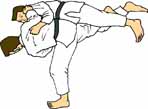 |
||||
|
||||
|
Your education in tae kwon do terminology begins with the name of the art itself. Tae kwon do is a Korean martial art whose name literally translates as the “foot fist way”. More eloquently put, it means the method of the foot and fist or the path of the feet and hands. From a fighting standpoint, this is self-explanatory. Tae (foot), kwon (fist), do can be explained as a technique of self-defense and fighting whose primary weapons are the feet and hands. What makes tae kwon do unique is the use of the Korean word do. |
Do translates as the way or the path in a more philosophical sense. When combined, these three simple words take on a whole new character from their literal translation. |
Tae kwon do Etiquette

Tae kwon do can be described as an idealistic and physical means of becoming one with the universe through the study of martial art.
Living fully and in harmony with ones surroundings through the perfection of the art is living on the path or do.
A traditional school will use both tae kwon do terminology and bowing when addressing others.
Bowing is often misunderstood by Westerners.
It is not an act of submission or subservience but a very obvious and outward show of respect. Bowing signifies respect for yourself, tae kwon do, and the wonderful abundance of life in general.We bow to our instructors and seniors.
A junior belt will bow to a senior belt to show respect and admiration for their higher rank.
A senior belt will bow to a junior belt to show appreciation for their willingness to train and attend classes.
We bow as we enter and leave our school, when we enter and leave a do-jang (gym room) and as a greeting to all members of our school.
In Asian culture, bowing is a symbol of deep regard and caring for the rights and lives of others.
"The respect of those you respect is worth more than the applause of the multitude."
-Arnold Glasgow
-Arnold Glasgow
Some of the first words you will learn in tae kwond do terminology are numbers.

Adults and children are encouraged to count to ten during repetitious exercises. Ordinal numbers are used to identify segments of the tae kwon do forms.
Tae kwon do terminology are the Korean words used to identify various techniques and instructions from Master to student. From simple greetings and titles of address, to the words for punch, kick or block are used daily in a taekwondo school and classroom dojang.
Words of greeting and thanks are used commonly in the kwan as they should be in life outside the school. Tae kwon do terminology makes frequent use of titles when adressing fellow students and teachers.
![]() Korean Language | Counting and Numbers
Korean Language | Counting and Numbers

There are many general words used to identify objects like your uniform or your belt level. You may even see these words printed on testing forms and flyers in your school.
Commands for Movements
If you like Taekwondo-Network please consider making a Donation. Your help will let TKDN grow to become the Premier tae kwon do site on the web. Kam sa ham ni dah!
FREE Tae kwon do Clipart
Get martial arts clipart like the one below! 50 + images available for your use. Click the Clipart button and follow instructions to get the download.Find a topic...

Custom Search
Homepage | Blog | Site News | Store | Privacy Policy | Sitemap
Belts | Classes | Clipart | Forms | History | Injury Prevention | Kids | Martial Arts |Master | Meditation | Men
Olympic | Philosophy | Self Denfense | Styles | Tea | Techniques | Terminology | Tournaments | Women | Vegetarian
Belts | Classes | Clipart | Forms | History | Injury Prevention | Kids | Martial Arts |Master | Meditation | Men
Olympic | Philosophy | Self Denfense | Styles | Tea | Techniques | Terminology | Tournaments | Women | Vegetarian
Copyright©
2008-2016 The Taekwondo Network. Always check with a physician before beginning any exercise regimen.
No reproduction of material without express written permission of the webmaster.
Taekwondo top of Page

